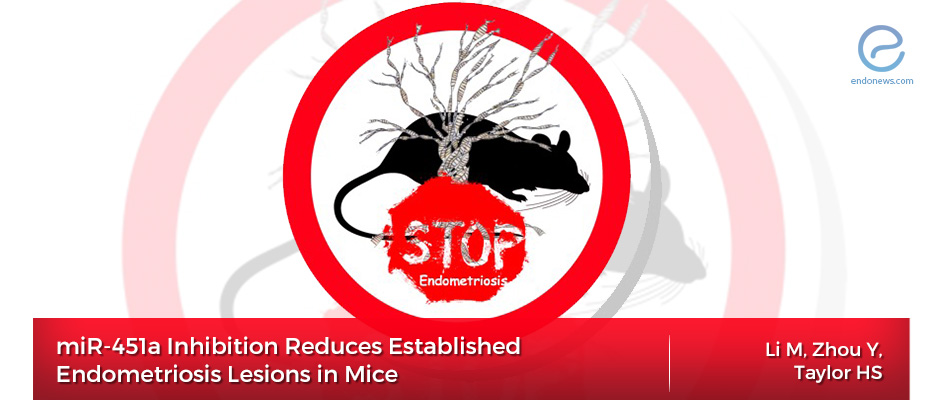MicroRNA Inhibitor as an Endometriosis treatment
Sep 9, 2019
miR-451a Inhibition Reduces Endometriosis Lesions in Mice
Key Points
Highlight:
- Dr. Taylor group shows that systemic treatment of miR-451 inhibitor has potential as endometriosis treatment.
Background:
- Various studies have been tried to identify molecular signatures which are ectopically expressed in endometriosis patients.
- However, current treatment limits mainly targeting sex steroids.
- In endometriosis, a set of miRNAs was found to change their expressional level, suggesting the dysregulated miRNAs might be a good target for endometriosis.
- Dr. Taylor group previously reported that endometriosis patients have a higher expression of miR-451, which is involved in numerous events including cell proliferation, differentiation, migration, and invasion.
- The authors have decided to examine if the inhibition of endometriosis-specific miR-451 reduces endometriosis and can be a good therapeutic option.
Key points:
- After endometriosis was induced using well-established syngeneic endometriosis protocol, mice were treated systemically either control or miR-451 inhibitor.
- Compared to the control group, the treatment of miR-451 inhibitor significantly reduced the size of endometriosis lesion, but the number of lesions was not changed.
- miR-451 inhibitor treatment also changed the expression of YWHAZ, CAB39, MAPK1, b-catenin, and IL-6, which are involved in endometriosis-associated inflammation or growth.
Conclusions:
- The treatment of miR-451 inhibitor resulted in the reduction of endometriosis lesion sizes and changed the expression of critical genes in the pathophysiology of endometriosis.
- Systemic administration by the intravenous injection makes the treatment more clinically applicable, and the miR-451 inhibitor can be an effective endometriosis-specific treatment in the future.
Lay Summary
Endometriosis is a well-known estrogen-dependent gynecological disorder. This disease affects approximately 20% to 50% of infertile women and 10% of reproductive-aged women resulting in infertility and pelvic pains.
In order to find endometriosis-specific treatment, various studies have been tried to identify molecular signatures which are ectopically expressed in endometriosis patients. Unfortunately, current medical treatment is not endometriosis specific but targets sex steroids broadly. Therefore, precision medicine, which reduces side effects significantly, is highly required for medically treating endometriosis in the near future.
MicroRNAs (miRNAs) are endogenous small non-coding RNAs. They play important regulatory roles in animals by degrading their target messenger RNA transcripts. In endometriotic tissue, a set of miRNAs was found to change their expressional level suggesting their dysregulation might play a critical role in endometriosis. Recently, miR-451, one of those specifically dysregulated miRNAs in endometriotic tissue, was found to be involved in numerous events including cell proliferation, differentiation, migration, and invasion, all of which are important for the survival of endometriotic implants and implies the critical involvement in endometriosis pathogenesis.
In the previous study with endometriosis patients, Dr. Taylor group showed that miR-451 was highly expressed in the patient’s serum. Based on the finding, they decided to examine if the inhibition of endometriosis-specific miR-451 reduces endometriosis and can be a possible treatment option. This study recently published in the journal of “Reproductive Sciences”.
For the in vivo mouse study, endometriosis was induced using well-established syngeneic endometriosis protocol. After endometriosis was developed, mice were treated systemically either control or miR-451 inhibitor. After four weeks of treatment, mice were sacrificed and their lesions were analyzed. Compared to the control group, the treatment of miR-451 inhibitor significantly reduced the size of endometriosis lesion. However, the number of lesions was not different from the groups. They next analyzed the gene expression in the lesions. They measured selected genes which are involved in endometriosis-associated inflammation or growth. miR-451 inhibitor treatment increased the expression of YWHAZ, CAB39, MAPK1, b-catenin, and IL-6 when it compared to the control.
In conclusion, the authors demonstrated that the treatment of miR-451 inhibitor resulted in the reduction of endometriosis lesion sizes and changed gene expressions which are involved in the pathophysiology of endometriosis. Systemic administration by the intravenous injection makes this treatment more clinically applicable, the miR-451 inhibitor can be an effective endometriosis-specific treatment in the future.
Research Source: https://www.ncbi.nlm.nih.gov/pubmed/?term=31354069
Endometriosis microRNA miR-451 Oligonucleotide treatment

